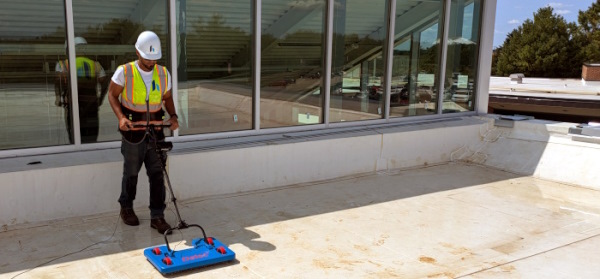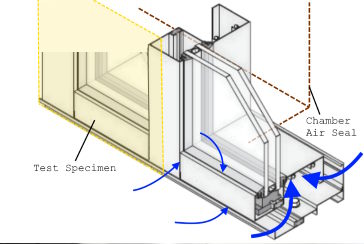
Purpose
Waterproof membranes serve as the primary defense against moisture intrusion in roofs, plaza decks, pools, water features, and other critical waterproofing applications. However, breaches can occur due to installation defects, material failures, or post-installation damage from construction activities or environmental wear.
Leak detection is especially challenging when membranes are installed beneath overburdens such as insulation, soil (green roofs), or pavers. Identifying breaches before these layers are added prevents expensive excavation, repairs, and secondary damage.
ASTM D7877 standardizes ELD procedures to support quality control, forensic analysis, and long-term maintenance strategies. This procedure is particularly useful for validating roof integrity at multiple stages of construction:
- Post-installation verification – Ensures that the roofing contractor delivers a complete and defect-free system before exposure to additional construction traffic.
- Pre-occupancy testing – Confirms waterproofing integrity before the building is placed into service.
- Pre-installation of interior finishes – Avoids costly damage to drywall, flooring, and insulation by identifying and repairing breaches before these materials are installed.
By integrating Electronic Leak Detection (ELD) at these stages, owners, contractors, and consultants can proactively address membrane vulnerabilities, reducing long-term risks and lifecycle costs.
^ Back to Top
Core Principles of Electronic Leak Detection (ELD)
ELD operates on the principle of electrical conductivity:
- Waterproof membranes are non-conductive (most, anyway), creating a natural barrier.
- A conductive substrate beneath the membrane allows for controlled electrical current flow.
- When water passes through a breach, it completes the circuit, allowing precise identification of leak locations.
There are two primary ELD methodologies:
1. Low-Voltage Testing (Horizontal and Vertical Applications)
Low-voltage ELD is ideal for new membrane installations and periodic maintenance testing. It requires a thin layer of water to act as a conductive bridge between a test probe and any breach in the membrane. Variations of this method include the following:
- Scanning Platform Method – A dual-sweep system that detects current flow through water applied to the membrane.
- Electric Field Vector Mapping (EFVM) – Uses a perimeter wire and voltage differential to triangulate breach locations.
- Vertical Surface Scanning – Uses a moistened roller to test walls, parapets, and other vertical membrane applications.
Limitations:
- Requires continuous water coverage for conductivity.
- Most test equipment is not effective on conductive membranes (e.g., black EPDM) without specialized systems (though some platforms exist with the capabilities to test black EPDM)
- False positives can occur.
2. High-Voltage Testing
High-voltage ELD is used when the membrane is dry and exposed. A charged electrode brush is swept over the surface, and if a breach is present, an electrical arc forms between the probe and the conductive substrate below.
^ Back to Top
The Importance of a Conductive Substrate for ELD
ELD requires a continuous conductive path beneath the membrane to complete the electrical circuit. If a non-conductive insulation or cover board is installed between the membrane and the substrate, standard ELD testing will not function correctly.
Challenges with Non-Conductive Substrates:
- Conventional roof assemblies often include insulating foam, protection boards, or cover boards, which disrupt the electrical path
- Some assume water will seep through the cover board to create a conductive path—however, most modern cover boards are water-resistant, making this unreliable. Be wary of any test results conducted on overburdens without a conductive primer immediately below the membrane
- Mechanically attached membranes do not always create a reliable return path unless a breach occurs directly over a fastener plate
Solutions: Conductive Primers
To enable ELD in non-conductive assemblies, most major roof membrane manufacturers offer conductive primers, such as TruGround. These primers:
- Are applied directly beneath the membrane, creating a conductive layer
- Allow for both low-voltage and high-voltage testing.
- Are compatible with fully adhered, mechanically attached, and torch-down membranes.
- Eliminate the need for wire mesh, which is often misapplied beneath cover boards and fails to function correctly
Additionally, roofing applied directly to conductive concrete or metal decking provides an inherent conductive substrate, allowing ELD to function without additional materials
Best Practices
- Verify substrate conductivity before testing.
- Specify conductive primers in assemblies with cover boards or insulation.
- Ensure the conductive layer is directly beneath the membrane, not under insulation or protection boards.
^ Back to Top

Equipment Calibration and Operator Training
Successful ELD testing requires skilled operators and properly calibrated equipment.
Operator Proficiency
ELD is highly sensitive, and improper execution can lead to false positives or missed breaches. Operators should receive comprehensive hands-on training to:
- Understand how to interpret readings accurately.
- Recognize the impact of substrate conditions on test results.
- Differentiate between actual breaches and false positives, such as interference from grounded components.
Without adequate training, results may be misinterpreted, leading to incorrect conclusions. Given the nuances of ELD, it is strongly recommended that operators develop regular proficiency before conducting independent testing.
Calibration Requirements
Leak detection equipment must be routinely verified for accuracy. While specific calibration procedures vary by manufacturer, standard best practices include:
- Verifying detection sensitivity before each test.
- Regularly confirming that voltage settings align with membrane properties.
- Ensuring that high-voltage testing is performed at appropriate levels to avoid damaging membranes.
^ Back to Top

Conclusion
Electronic Leak Detection (ELD) is a highly effective method for verifying the integrity of waterproof membranes, but its success depends on proper implementation. ASTM D7877 provides a standardized framework for accurate, repeatable testing, ensuring quality control, forensic analysis, and long-term maintenance.
To maximize effectiveness:
- Ensure a conductive substrate is present—if necessary, specify conductive primers like TruGround.
- Select the appropriate ELD method based on membrane type and site conditions.
- Train operators to recognize actual breaches versus false positives.
- Integrate ELD testing at multiple construction milestones for proactive risk mitigation.
By following these best practices, stakeholders can reduce water infiltration risks, extend membrane service life, and avoid costly repairs to interior conditions and other systems affected by water damage.
^ Back to Top







